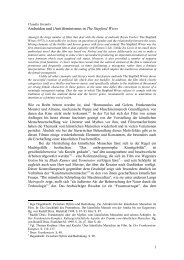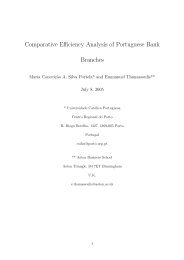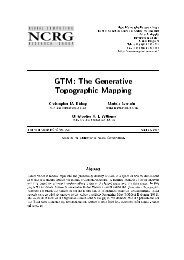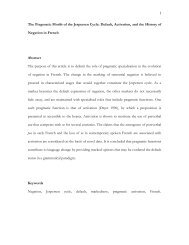PDF (Adipokines have a role to play in - Aston University Research ...
PDF (Adipokines have a role to play in - Aston University Research ...
PDF (Adipokines have a role to play in - Aston University Research ...
Create successful ePaper yourself
Turn your PDF publications into a flip-book with our unique Google optimized e-Paper software.
Edi<strong>to</strong>rial<br />
SpEcial FocuS: MEtabolic SyndroME<br />
For repr<strong>in</strong>t orders, please contact repr<strong>in</strong>ts@future-science.com<br />
<strong>Adipok<strong>in</strong>es</strong> <strong>have</strong> a <strong>role</strong> <strong>to</strong> <strong>play</strong> <strong>in</strong> the<br />
treatment of metabolic disease<br />
“Up until now drug therapy has failed <strong>in</strong> mak<strong>in</strong>g a major impact <strong>in</strong> the treatment of obesity.”<br />
Keywords: adipk<strong>in</strong>es metabolic disease obesity obesity drugs<br />
The world is suffer<strong>in</strong>g from an obesity epidemic<br />
and most healthcare systems are under tremendous<br />
stra<strong>in</strong> <strong>to</strong> deal with these patients. With<br />
obesity comes cardiovascular disease, Type II<br />
diabetes, <strong>in</strong>creased cancer <strong>in</strong>cidences and<br />
ultimately reduced life expectancy (FigurE 1) [1,2].<br />
Up until now, drug therapy has failed <strong>in</strong><br />
mak<strong>in</strong>g a major impact <strong>in</strong> the treatment of<br />
obesity. The most recent drug advances such as<br />
Rimonabant and Sibutram<strong>in</strong>e <strong>have</strong> failed.<br />
A surgical approach is another option. Gastric<br />
band<strong>in</strong>g, however, is expensive and approximately<br />
only 1% of eligible patients <strong>have</strong> the surgery.<br />
Would this be <strong>to</strong>lerated if it was hip replacement<br />
patients? Treat<strong>in</strong>g larger numbers of patients<br />
for obesity will require drugs that <strong>have</strong> fewer<br />
side effects with better than 10% weight loss at<br />
reasonable cost.<br />
Adipose tissue was orig<strong>in</strong>ally thought <strong>to</strong> be<br />
only for s<strong>to</strong>rage of triglycerides and noth<strong>in</strong>g<br />
else, but advances over the last 15 years <strong>have</strong><br />
shown that white adipose tissue (WAT) is a<br />
major endocr<strong>in</strong>e organ produc<strong>in</strong>g clearly <strong>in</strong>dentified<br />
adipok<strong>in</strong>es (lept<strong>in</strong> and adiponect<strong>in</strong>) and<br />
cy<strong>to</strong>k<strong>in</strong>es (TNF-a and IL-6). There is also<br />
migration of macrophages and therefore chronic<br />
<strong>in</strong>flammation (FigurE2) [3].<br />
Understand<strong>in</strong>g these new adipok<strong>in</strong>es and<br />
their place <strong>in</strong> metabolic disease will hopefully<br />
lead <strong>to</strong> new targets and therapies for the<br />
treatment of metabolic disease.<br />
<strong>Adipok<strong>in</strong>es</strong> as possible targets<br />
for therapy<br />
Lept<strong>in</strong><br />
Lept<strong>in</strong> is a 16-kDa nonglycosylated peptide<br />
belong<strong>in</strong>g <strong>to</strong> the cy<strong>to</strong>k<strong>in</strong>e class 1 super family.<br />
It was identified as the first adipok<strong>in</strong>e as it is<br />
almost exclusively expressed <strong>in</strong> WAT, particularly<br />
<strong>in</strong> subcutaneous fat (where 80% of lept<strong>in</strong><br />
is produced) [4].<br />
10.4155/FMC.10.265 © 2010 Future Science Ltd<br />
Orig<strong>in</strong>ally thought only <strong>to</strong> act centrally, it is<br />
now clear that it acts peripherally <strong>in</strong> a large number<br />
of tissues, for example adipocytes where it<br />
can <strong>in</strong>fluence the rate of lipolysis. It also reduces<br />
food <strong>in</strong>take and <strong>in</strong>creases energy consumption,<br />
as well as <strong>in</strong>hibit<strong>in</strong>g orexigenic neuropeptides [5].<br />
Although this prote<strong>in</strong> was not successful when<br />
put <strong>in</strong><strong>to</strong> cl<strong>in</strong>ical practice, it has opened up a field<br />
of research that should provide a more targeted<br />
approach <strong>to</strong> obesity treatment.<br />
Adiponect<strong>in</strong><br />
Adiponect<strong>in</strong> is a prote<strong>in</strong> produced ma<strong>in</strong>ly <strong>in</strong><br />
WAT that <strong>in</strong>creases fatty acid oxidation while<br />
reduc<strong>in</strong>g glucose synthesis <strong>in</strong> the liver [6]. In<br />
knock-out mice on a normal diet there is no<br />
effect but on a high-fat diet mice develop severe<br />
<strong>in</strong>sul<strong>in</strong> resistance and <strong>have</strong> lipid accumulation <strong>in</strong><br />
muscles. These f<strong>in</strong>d<strong>in</strong>gs suggest that adiponect<strong>in</strong><br />
has a key <strong>role</strong> <strong>to</strong> <strong>play</strong> <strong>in</strong> energy balance [7].<br />
There is decreased adiponect<strong>in</strong> expression<br />
observed <strong>in</strong> obese patients and this is associated<br />
with <strong>in</strong>sul<strong>in</strong> resistance and Type II diabetes.<br />
Adiponect<strong>in</strong> can affect hepatic glucose<br />
and decrease mRNA for key gluconeogenisis<br />
enzymes [8]. This <strong>in</strong>dicates that it may be a useful<br />
target <strong>in</strong> metabolic disease, especially now<br />
two key recep<strong>to</strong>rs, adipoR1 and adipoR2 <strong>have</strong><br />
been shown <strong>to</strong> <strong>play</strong> a <strong>role</strong> <strong>in</strong> lipid and glucose<br />
metabolism, <strong>in</strong>flammation and oxidative stress.<br />
These appear <strong>to</strong> warrant further <strong>in</strong>vestigation.<br />
Resist<strong>in</strong><br />
In the search for new and improved thiazolid<strong>in</strong>ediones<br />
(TZDs), resist<strong>in</strong> was identified. Resist<strong>in</strong><br />
is <strong>in</strong>creased <strong>in</strong> obese animals and decreased <strong>in</strong><br />
the presence of TZDs; it is also able <strong>to</strong> decrease<br />
glucose transport <strong>in</strong> vitro [9]. It has the ability<br />
<strong>to</strong> <strong>in</strong>hibit adipocyte differentiation [10] and<br />
therefore may be a good target for the treatement<br />
of Type II diabetes. In humans there <strong>have</strong><br />
Future Med. Chem. (2010) 2(12), 1721–1724<br />
Steve T Russell<br />
Nutritional Biomedic<strong>in</strong>e, School of Life<br />
and Health Sciences, As<strong>to</strong>n <strong>University</strong>,<br />
As<strong>to</strong>n Triangle, Birm<strong>in</strong>gham,<br />
B4 7ET, UK<br />
Tel.: +44 121 204 4005<br />
E-mail: s.t.russell1@as<strong>to</strong>n.ac.uk<br />
ISSN 1756-8919<br />
1721
Edi<strong>to</strong>rial | Russell<br />
Pulmonary disease<br />
• Abnormal funtion<br />
• Obstrutive sleep apnea<br />
• Hypoventilation syndrome<br />
Nonalcoholic fatty liver disease<br />
• Stea<strong>to</strong>sis<br />
• Stea<strong>to</strong>hepatitis<br />
• Cirrhosis<br />
Gall bladder disease<br />
Gynecologic abnormalities<br />
• Abnormal menses<br />
• Infertility<br />
• Polycystic ovarian syndrome<br />
Osteoarthiritis<br />
been contradic<strong>to</strong>ry results. First, there is debate<br />
about which organ secretes resist<strong>in</strong>. Second,<br />
there is also debate about the circulat<strong>in</strong>g levels<br />
<strong>in</strong> plasma. Further studies are required <strong>to</strong> elucidate<br />
its mechanism of action, however it would<br />
appear <strong>to</strong> be a potential target for therapy.<br />
Z<strong>in</strong>c-a2-glycoprote<strong>in</strong><br />
Z<strong>in</strong>c-a2-glycoprote<strong>in</strong> (ZAG) was identified as<br />
<strong>play</strong><strong>in</strong>g a <strong>role</strong> <strong>in</strong> lipid metabolism and is thought<br />
<strong>to</strong> be responsible for loss of adipose <strong>in</strong> cancer<br />
cachexia patients [11]. ZAG stimulates lipolysis<br />
<strong>in</strong> mur<strong>in</strong>e adipocytes by activation of adenylyl<br />
cyclase <strong>in</strong> a GTP-dependent process [12]. ZAG<br />
has been shown <strong>to</strong> be produced <strong>in</strong> the liver,<br />
brown adipose and WAT [12].<br />
Our group has published a number of papers<br />
show<strong>in</strong>g reduced weight <strong>in</strong> normal mice and<br />
ob/ob mice when dosed with purified ZAG<br />
with improved glucose <strong>to</strong>lerance [13,14]. These<br />
treated mice showed <strong>in</strong>creased energy expenditure<br />
though <strong>in</strong>creased uncoupl<strong>in</strong>g prote<strong>in</strong>s and<br />
changes <strong>in</strong> glucose and fatty acid oxidation.<br />
Moreover, <strong>in</strong> both cachectic mice [12] and<br />
humans [15], expression of ZAG mRNA <strong>in</strong><br />
WAT was found <strong>to</strong> be <strong>in</strong>creased tenfold [12] and<br />
Medical complications of obesity<br />
2.7-fold [15], respectively. In cachectic cancer<br />
patients ZAG mRNA showed a negative correlation<br />
with body mass <strong>in</strong>dex (BMI), but a positive<br />
correlation with weight loss and serum-glycerol<br />
levels [15]. In contrast, ZAG mRNA levels <strong>in</strong><br />
WAT <strong>have</strong> been shown <strong>to</strong> be downregulated <strong>in</strong><br />
obesity and correlated negatively with fat mass,<br />
BMI, plasma <strong>in</strong>sul<strong>in</strong> and lept<strong>in</strong> [16]. Treatment of<br />
ob/ob mice with ZAG decreased body weight and<br />
fat mass and improved the parameters of <strong>in</strong>sul<strong>in</strong><br />
resistance <strong>in</strong>clud<strong>in</strong>g decreas<strong>in</strong>g plasma levels of<br />
glucose, <strong>in</strong>sul<strong>in</strong> and non-esterified fatty acids,<br />
improv<strong>in</strong>g <strong>in</strong>sul<strong>in</strong> sensitivity and <strong>in</strong>creas<strong>in</strong>g muscle<br />
mass [14]. While ZAG overexpression <strong>in</strong> mice<br />
reduced both the body weight and weight of epididymal<br />
fat [17], ZAG-knockout animals showed<br />
an <strong>in</strong>creased body weight, especially when fed a<br />
high-fat diet [18]. These results suggest that ZAG,<br />
like lept<strong>in</strong>, is closely associated with fat mass.<br />
However, while lept<strong>in</strong> is positively correlated<br />
with fat mass, ZAG is negatively correlated.<br />
The endocannab<strong>in</strong>oid system<br />
Endocannab<strong>in</strong>oids, although not a true adipok<strong>in</strong>e,<br />
can <strong>in</strong>fluence lipolysis and fatty acid<br />
metabolism along with energy balance. Act<strong>in</strong>g<br />
1722 Future Med. Chem. (2010) 2(12)<br />
future science group<br />
Sk<strong>in</strong><br />
Gout<br />
Idiopathic <strong>in</strong>tracranial hypertension<br />
Stroke<br />
Cataracts<br />
Coronary heart disease<br />
Diabetes<br />
Dyslipidemia<br />
Hypertension<br />
Severe pancreatitis<br />
Cancer<br />
• Breast, uterus, cervix<br />
colon, eosophagus, pancreas,<br />
kidney and prostate<br />
Phlebitis<br />
Venous stasis<br />
Figure 1. Obesity leads <strong>to</strong> enormous stra<strong>in</strong> on a great deal of the body’s systems lead<strong>in</strong>g<br />
<strong>to</strong> cardiovascular disease, diabetes and decreased life expectancy.
though the cannaboid recep<strong>to</strong>r (CB1) they can<br />
<strong>in</strong>duce glucose uptake and <strong>in</strong>hibi<strong>to</strong>rs can act<br />
centrally <strong>to</strong> suppress appetite [19]<br />
CB1 antagonists (e.g., Rimonabant)<br />
decreases body weight and food <strong>in</strong>take but<br />
suppression of other CNS processes leads <strong>to</strong><br />
suicidal thoughts and depression [20]. Perhaps<br />
a more targeted approach is required that<br />
avoids the CB1 antagonist cross<strong>in</strong>g over the<br />
blood–bra<strong>in</strong> barrier, or possibly target<strong>in</strong>g the<br />
CB2 recep<strong>to</strong>r.<br />
Macrophages & <strong>in</strong>flammation<br />
Macrophage <strong>in</strong>filtration <strong>in</strong><strong>to</strong> adipose tissue<br />
leads <strong>to</strong> low-grade chronic <strong>in</strong>flammation<br />
though the production of adipok<strong>in</strong>es, cy<strong>to</strong>k<strong>in</strong>es<br />
(TNF-a and IL-6). BMI correlates<br />
strongly with the number of macrophages [21],<br />
which are shown <strong>to</strong> decrease after gastric<br />
band<strong>in</strong>g [22].<br />
Pro-<strong>in</strong>flamma<strong>to</strong>ry cy<strong>to</strong>k<strong>in</strong>es <strong>in</strong> adipose tissue<br />
may be due <strong>to</strong> the presence of these macrophages.<br />
Also recep<strong>to</strong>rs <strong>in</strong>volved <strong>in</strong> immune<br />
response trigger transduction pathways lead<strong>in</strong>g<br />
<strong>to</strong> <strong>in</strong>creased expression of pro-<strong>in</strong>flamma<strong>to</strong>ry<br />
cy<strong>to</strong>k<strong>in</strong>es, thus decreas<strong>in</strong>g IRS and <strong>in</strong>hibit<strong>in</strong>g<br />
NFkB [23].<br />
<strong>Research</strong> on adipose tissue and adipok<strong>in</strong>es has<br />
changed our understand<strong>in</strong>g of the pathophysiology<br />
of obesity and <strong>in</strong>sul<strong>in</strong> resistance. Macrophage<br />
<strong>in</strong>filtration offers a new target for therapy and<br />
shows the need <strong>to</strong> focus on subcellular structures<br />
and <strong>in</strong>tracellular signal<strong>in</strong>g methods.<br />
Future perspective<br />
Metabolic syndrome, be it <strong>in</strong>sul<strong>in</strong> resistance,<br />
obesity, Type II diabetes or a comb<strong>in</strong>ation<br />
thereof, is a complex medical target that may<br />
require a multi-discipl<strong>in</strong>ary approach for<br />
effective treatment.<br />
<strong>Adipok<strong>in</strong>es</strong> offer new targets for therapy.<br />
I <strong>have</strong> only <strong>to</strong>uched on a few key adipok<strong>in</strong>es<br />
here and there are more still <strong>to</strong> be discovered.<br />
Ultimately it may mean that a comb<strong>in</strong>ation of<br />
Bibliography<br />
Papers of special note <strong>have</strong> been highlighted as:<br />
of <strong>in</strong>terest<br />
of considerable <strong>in</strong>terest<br />
1 Rennie KL, Jebb SA. Prevalence of obesity <strong>in</strong><br />
Great Brita<strong>in</strong>. Obes. Rev. 6, 11–12 (2005).<br />
2 Bask<strong>in</strong> ML, Ard J, Frankl<strong>in</strong> F, Allison DB.<br />
Prevalence of obesity <strong>in</strong> the United States.<br />
Obes. Rev. 6, 5–7 (2005).<br />
future science group<br />
<strong>Adipok<strong>in</strong>es</strong> <strong>have</strong> a <strong>role</strong> <strong>to</strong> <strong>play</strong> <strong>in</strong> the treatment of metabolic disease | Edi<strong>to</strong>rial<br />
Cy<strong>to</strong>k<strong>in</strong>es<br />
Macrophage<br />
migration<br />
Tissue fac<strong>to</strong>rs<br />
drugs is required <strong>to</strong> effect a change <strong>in</strong> energy<br />
balance for successful weight loss and a<br />
normalization of metabolic balance.<br />
Meanwhile, lifestyle changes, cognitive psychotherapy<br />
and government <strong>in</strong>tervention may<br />
also <strong>play</strong> a <strong>role</strong> as health services collapse under<br />
the pressure of the obesity epidemic. It is direct<br />
<strong>in</strong>tervention through drugs and surgery that will<br />
ultimately provide the answers.<br />
F<strong>in</strong>ancial & compet<strong>in</strong>g <strong>in</strong>terests disclosure<br />
The author is funded by Halsa Pharmaceuticals, which<br />
holds several patents on the use of Z<strong>in</strong>c-a-glycoprote<strong>in</strong> <strong>in</strong><br />
the treatment metabolic disease. The correspond<strong>in</strong>g author<br />
is also the co-discoverer on one of these patents. The author<br />
has no other relevant affiliations or f<strong>in</strong>ancial <strong>in</strong>volvement<br />
with any organization or entity with a f<strong>in</strong>ancial <strong>in</strong>terest <strong>in</strong><br />
or f<strong>in</strong>ancial conflict with the subject matter or materials<br />
discussed <strong>in</strong> the manuscript apart from those disclosed.<br />
No writ<strong>in</strong>g assistance was utilized <strong>in</strong> the production of<br />
this manuscript.<br />
3 Trayhurn P, Wood IS. <strong>Adipok<strong>in</strong>es</strong>:<br />
<strong>in</strong>flammation and the pleiotropic <strong>role</strong> of white<br />
adipose tissue. Br. J. Nutr. 92, 347–355<br />
(2004).<br />
4 Ahima RS, Flier JS. Lept<strong>in</strong>. Annu. Rev.<br />
Physiol. 62, 413–437 (2000)<br />
5 Zhang Y, Proenca R, Maffei M, Barone M,<br />
Leopold L, Friedman JM. Positional clon<strong>in</strong>g<br />
of the mouse obese gene and its human<br />
homologue. Nature 372, 425–432 (1994).<br />
www.future-science.com<br />
Resist<strong>in</strong><br />
Lept<strong>in</strong><br />
Adiponect<strong>in</strong><br />
Oestrogen<br />
Visfat<strong>in</strong><br />
Adips<strong>in</strong><br />
Agouti<br />
Z<strong>in</strong>c-αglycoprote<strong>in</strong><br />
Others<br />
Figure 2. An adipocyte and the fac<strong>to</strong>rs that are known <strong>to</strong> be released<br />
from adipocytes. These <strong>in</strong>clude adipok<strong>in</strong>es, cy<strong>to</strong>k<strong>in</strong>es and other fac<strong>to</strong>rs that<br />
<strong>in</strong>fluence energy expenditure and metabolic disease.<br />
Kick started the area of adipok<strong>in</strong>e research.<br />
6 Berg AH, Scherer PE. Adipose tissue,<br />
<strong>in</strong>flammation and cardiovascular disease.<br />
Circ. Res. 96, 939–949 (2005).<br />
7 Waki H, Yamauchi T, Kamon J. Impaired<br />
multimerization of human adiponect<strong>in</strong><br />
mutants associated with diabetes: molecular<br />
structure and multimer formation of<br />
adiponect<strong>in</strong>. J. Biol. Chem. 278,<br />
40352–40363 (2003)<br />
1723
Edi<strong>to</strong>rial | Russell<br />
8 Kadowaki T, Yamauchi T. Adiponect<strong>in</strong> and<br />
adiponect<strong>in</strong> recep<strong>to</strong>rs. Endocr<strong>in</strong>. Rev. 26,<br />
439–451(2005)<br />
9 Steppan CM, Bailey ST, Bhat S.<br />
The hormone resist<strong>in</strong> l<strong>in</strong>ks obesity <strong>to</strong><br />
diabetes. Nature 409, 307–312 (2001).<br />
Key paper <strong>in</strong> the l<strong>in</strong>k between obesity<br />
and diabetes.<br />
10 Kim KH, Lee K, Moon YS, Sul HK.<br />
A cyste<strong>in</strong>e-rich adipose tissue specific<br />
secre<strong>to</strong>ry fac<strong>to</strong>r <strong>in</strong>hibits adipocyte<br />
differentiation. J. Biol. Chem. 276,<br />
11252–11256 (2001).<br />
11 Todorov PT, McDevitt TM, Meyer DJ,<br />
Ueyama H, Ohkubo I, Tisdale MJ.<br />
Purification and characterization of a<br />
tumour-lipid mobiliz<strong>in</strong>g fac<strong>to</strong>r.<br />
Cancer Res. 58, 2353–2358 (1998).<br />
Key paper <strong>in</strong> the identification of Z<strong>in</strong>c-a2glycoprote<strong>in</strong><br />
(ZAG).<br />
12 B<strong>in</strong>g C, Bao Y, Jenk<strong>in</strong>s J. Z<strong>in</strong>c-a2glycoprote<strong>in</strong>,<br />
a lipid mobiliz<strong>in</strong>g fac<strong>to</strong>r, is<br />
expressed <strong>in</strong> adipocytes and is up-regulated <strong>in</strong><br />
mice with cancer cachexia. Proc. Natl<br />
Acad. Sci. 101, 2500–2505 (2004).<br />
13 Russell ST, Zimmerman TP, Dom<strong>in</strong> BA,<br />
Tisdale MJ. Induction of lipolysis <strong>in</strong> vitro and<br />
loss of body fat <strong>in</strong> vivo by z<strong>in</strong>c-a2glycoprote<strong>in</strong>.<br />
Biochim. Biphys. Acta. 1636,<br />
59–68 (2004).<br />
14 Russell ST, Tisdale MJ. Antidiabetic<br />
properties of z<strong>in</strong>c-a2-glycoprote<strong>in</strong> <strong>in</strong> ob/ob<br />
mice. Endocr<strong>in</strong>ol 151, 948–957 (2010).<br />
Shows l<strong>in</strong>k between ZAG and diabetes.<br />
15 Mracek T, Stephens N, Gao D et al.<br />
Z<strong>in</strong>c-a2-glycoprote<strong>in</strong> <strong>in</strong> adipose atrophy <strong>in</strong><br />
human cancer cachexia. Presented at: The 5th<br />
Cachexia Conference. Barcelona, Spa<strong>in</strong>,<br />
5–8 December (2009).<br />
Key paper l<strong>in</strong>k<strong>in</strong>g ZAG with<br />
human cachexia.<br />
16 Mracek T, D<strong>in</strong>g Q, Tzanavari T et al.<br />
The adipok<strong>in</strong>e z<strong>in</strong>c-a2-glycoprote<strong>in</strong> is<br />
downregulated with fat mass expansion <strong>in</strong><br />
obesity. Cl<strong>in</strong>. Endocr<strong>in</strong>ol. 72, 334–341<br />
(2010).<br />
17 Gong F-Y, Zhang S-J, D<strong>in</strong>g J-Y et al.<br />
Z<strong>in</strong>c-a2-glycoprote<strong>in</strong> is <strong>in</strong>volved <strong>in</strong><br />
regulation of body weight through <strong>in</strong>hibition<br />
of lipogenic enzymes <strong>in</strong> adipose tissue.<br />
Int. J. Obese. 33, 1023–1030 (2009).<br />
Key paper l<strong>in</strong>k<strong>in</strong>g ZAG with human obesity.<br />
18 Rolli V, Radosavljevic M, Astier V et al.<br />
Lipolysis is altered <strong>in</strong> MHC Class I<br />
z<strong>in</strong>c-a2-glycoprote<strong>in</strong> deficient mice. FEBS<br />
Lett. 581, 394–400 (2007).<br />
19 Vet<strong>to</strong>r R, Pagano C. The <strong>role</strong> of the<br />
endocannab<strong>in</strong>oid system <strong>in</strong> lipogenesis and<br />
fatty acid metabolism. Best Pract. Res. Cl<strong>in</strong>.<br />
Endocr<strong>in</strong>ol. Metab. 23, 52–63 (2009).<br />
Excellent review of the subject area.<br />
20 Després JP, Van Gaal L, Pi-Sunyer X,<br />
Scheen A. Efficacy and safety of the<br />
weight-loss drug rimonabant.<br />
Lancet. 371(9612), 555 (2008).<br />
Important safety implications for a key<br />
weight-loss drug.<br />
21 Trayhurn P, Wood IS. Signall<strong>in</strong>g <strong>role</strong> of<br />
adipose tissue: adipok<strong>in</strong>es and <strong>in</strong>flammation<br />
<strong>in</strong> obesity. Biochem. Soc. Trans. 33,<br />
1078–1081 (2005).<br />
22 van Dielen FMH, Buurman WA,<br />
Hadfoune M, Nijhuis J, Greve J.<br />
Macrophage <strong>in</strong>hibi<strong>to</strong>ry fac<strong>to</strong>r, plasm<strong>in</strong>ogen<br />
activa<strong>to</strong>r <strong>in</strong>hibi<strong>to</strong>r-1, other acute phase<br />
prote<strong>in</strong>s and <strong>in</strong>flamma<strong>to</strong>ry media<strong>to</strong>rs<br />
normalize as a result of weight loss <strong>in</strong><br />
morbidly obese subjects treated with<br />
gastric restrictive surgery. J. Cl<strong>in</strong>. Endo. Met.<br />
89(8) 4062–4068 (2004)<br />
23 de Luca C, Olefsky JM. Inflammation and<br />
<strong>in</strong>sul<strong>in</strong> resistance. FEBS Lett. 582(1), 97–105<br />
(2008).<br />
1724 Future Med. Chem. (2010) 2(12)<br />
future science group















